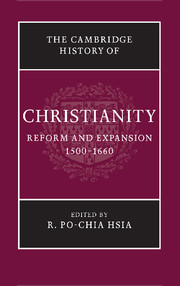Book contents
- Frontmatter
- Part I Luther and the Holy Roman Empire
- Part II The Second Reformation
- Part III Catholic Renewal
- Part IV Resolving Confessional Conflicts
- Part V Religion, Society, and Culture
- 19 The Reformation and the visual arts
- 20 Ritual in early modern Christianity
- 21 Music and religious change
- 22 Demonology, 1500–1660
- 23 Science and religion
- 24 The new clergies
- 25 Women and religious change
- Part VI Christianity and Other Faiths
- Bibliography
- Index
- References
22 - Demonology, 1500–1660
from Part V - Religion, Society, and Culture
Published online by Cambridge University Press: 28 March 2008
- Frontmatter
- Part I Luther and the Holy Roman Empire
- Part II The Second Reformation
- Part III Catholic Renewal
- Part IV Resolving Confessional Conflicts
- Part V Religion, Society, and Culture
- 19 The Reformation and the visual arts
- 20 Ritual in early modern Christianity
- 21 Music and religious change
- 22 Demonology, 1500–1660
- 23 Science and religion
- 24 The new clergies
- 25 Women and religious change
- Part VI Christianity and Other Faiths
- Bibliography
- Index
- References
Summary
Literally, demonology is the science of demons and their actions. The word ‘daimon’ is Greek and simply means a supernatural being, or a lesser divinity. In classical ancient Greece ‘daimones’ were perceived as guardian spirits, or as either good or evil spirits who try to influence the human psyche. However, in Christian theology, demons were always considered evil, whereas angels were thought to serve as God’s messengers or agents. Since the evil spirits were conceived as being masters of deception, an elaborate procedure of evaluation – the discernment of spirits (discretio spirituum) – was deemed necessary. This produced a science of angels – angelology –distinct from demonology. Theologically, demonology was based upon numerous references in the Bible, both in the ancient Jewish tradition and in the New Testament. A belief in spirit beings was fairly universal, as was a belief in related phenomena such as inspiration, spirit possession, and the struggle against possession by exorcism. Archaic religious systems such as shamanism were based on communication with spirits or spirit helpers. Inspiration was an important aspect of Christianity, and still is, as the feast of Pentecost indicates. To the dismay of the authorities, indigenous prophets continued to emerge from all corners of Europe, and various forms of spiritualism and prophecy remained part of European everyday life. Between 1500 and 1660 the medieval concept of demonology remained largely intact. It was shaped by St Augustine’s (354–430) idea that interactions between demons and humans were based on a contract, either explicit or implicit. This assumption was inspired by Roman law which viewed contracts as being mutually binding agreements.
- Type
- Chapter
- Information
- The Cambridge History of Christianity , pp. 406 - 424Publisher: Cambridge University PressPrint publication year: 2007
References
- 1
- Cited by



